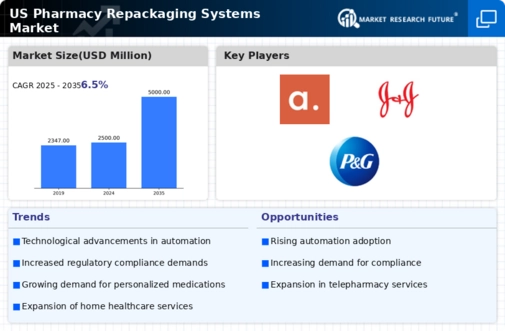Technological Advancements
Technological advancements play a pivotal role in shaping the pharmacy repackaging-systems market. Innovations such as artificial intelligence and machine learning are being integrated into repackaging systems, enabling more accurate medication dispensing and inventory management. These technologies enhance the precision of repackaging processes, thereby minimizing errors and improving patient safety. Furthermore, the market is projected to grow at a CAGR of 8% over the next five years, driven by the increasing adoption of these advanced technologies. As pharmacies continue to embrace digital transformation, the demand for sophisticated repackaging systems is expected to rise, further propelling the market forward.
Rising Demand for Efficiency
The pharmacy repackaging-systems market experiences a notable surge in demand for efficiency within pharmacy operations. As healthcare providers strive to optimize workflows, the adoption of advanced repackaging systems becomes increasingly prevalent. These systems facilitate streamlined processes, reducing the time spent on manual repackaging tasks. According to recent data, pharmacies that implement automated repackaging solutions report a reduction in labor costs by approximately 20%. This efficiency not only enhances productivity but also allows pharmacists to allocate more time to patient care. Consequently, the pharmacy repackaging-systems market is likely to witness sustained growth as pharmacies seek to improve operational efficiency and patient outcomes.
Growing Focus on Patient Safety
The pharmacy repackaging-systems market is significantly influenced by the growing focus on patient safety. With an increasing emphasis on reducing medication errors, pharmacies are turning to automated repackaging systems that enhance accuracy and reliability. These systems are designed to minimize human error, which is crucial in ensuring that patients receive the correct medications. Recent studies indicate that automated systems can reduce medication errors by up to 50%. As patient safety remains a top priority for healthcare providers, the demand for effective repackaging solutions is likely to escalate, thereby driving growth in the pharmacy repackaging-systems market.
Expansion of Specialty Pharmacies
The expansion of specialty pharmacies is emerging as a significant driver of the pharmacy repackaging-systems market. Specialty pharmacies cater to patients with complex health conditions, requiring tailored medication management and repackaging solutions. As the number of specialty pharmacies continues to grow, the demand for efficient repackaging systems that can handle unique medication regimens is likely to increase. This trend is further supported by the rising prevalence of chronic diseases, which necessitate specialized treatment plans. Consequently, the pharmacy repackaging-systems market is poised for growth as these pharmacies seek innovative solutions to meet the diverse needs of their patient populations.
Regulatory Pressures and Compliance
Regulatory pressures and compliance requirements are critical drivers of the pharmacy repackaging-systems market. Pharmacies must adhere to stringent regulations set forth by governing bodies, necessitating the implementation of systems that ensure compliance with safety and quality standards. The increasing complexity of these regulations compels pharmacies to invest in advanced repackaging solutions that can facilitate compliance and streamline reporting processes. As a result, the market is expected to expand as pharmacies seek to mitigate risks associated with non-compliance. The financial implications of regulatory fines can be substantial, further incentivizing the adoption of reliable repackaging systems.














Leave a Comment